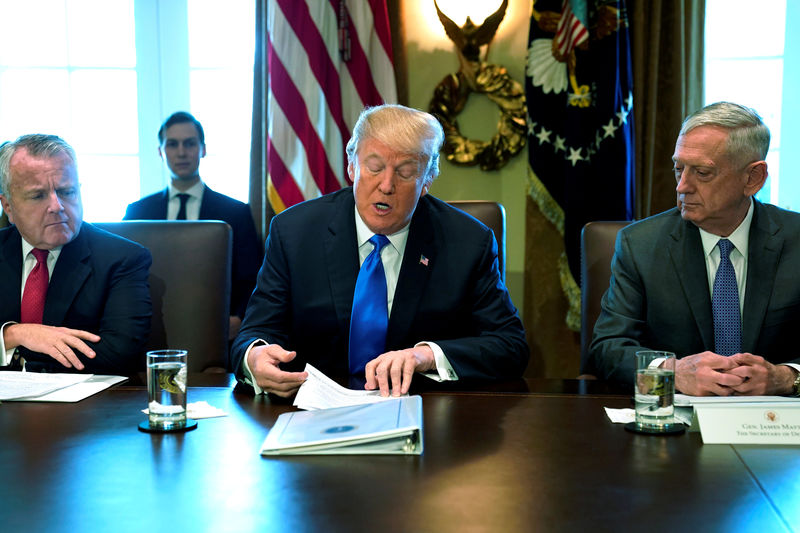By Jason Lange
WASHINGTON (Reuters) - President Donald Trump's campaign to shrink the "bloated federal bureaucracy" so far has made a small dent in the federal workforce, and that largely because of a decline in civilian defense jobs.
Days after his Jan. 20 inauguration, Trump ordered a hiring freeze later replaced with an order for federal agencies to cut staff immediately, and in March he proposed a 2018 budget that sought to shift $54 billion to the military from other departments.
However, federal civilian jobs declined around 6,000 in the first nine months of this year, or just 0.3 percent of 2.1 million such jobs tracked by the Office of Personnel Management, according to Reuters calculations based on the latest OPM data published in late October.
The White House Office of Management and Budget declined to comment on the overall drop in federal employment or the mix of job gains and losses across agencies. The Office issued in April the order for agencies to start near-term staffing cuts and to submit plans for longer-term reductions by September.
Trump has not detailed how much "fat" he aims to cut, but spoke of "billions and billions of dollars" of government waste and his aim to shrink the "bloated federal bureaucracy" while preparing his budget proposals in March.
Independent watchdogs agree the federal government could be made more efficient, with Congress's Government Accountability Office estimating in April that overlap and duplication lead to "tens of billions" of dollars in unnecessary spending.
Before Trump, Democrats Barack Obama and Bill Clinton and Republican George W. Bush have all spearheaded various efforts to streamline government bureaucracy.
David Lewis, a political science professor at Vanderbilt University, said this year's numbers showed that Trump's executive orders had limited power to reshape the federal bureaucracy. Ultimately, the Congress controlled the budgets and had the biggest sway over agencies' staffing, said Lewis, whose research has largely focused on executive branch politics and public administration.
The White House has said agencies' longer-term workforce reduction plans will serve to develop Trump's 2019 budget proposal.
The overall decline in federal staffing this year is largely due to a roughly 9,500 drop at the Department of Defense to about 731,000, a 1.3 percent decline, even though Trump's budget proposal envisaged small increases between 2016 and 2018 in employment measured by hours worked.
Pentagon spokesman Dave Eastburn said hiring was slow during the White House-ordered freeze, but exemptions allowed recruitment for mission-critical positions and military readiness was never affected. He described the decrease in staffing this year as "well within historical norms."
In fact, the number of active-duty service personnel, which was exempt from the hiring freeze, grew by about 7,000 in the 12 months through September, according to Defense Department data.
Still, cuts in the civilian staff could push more work onto relatively expensive contractors and military officers, potentially raising costs over time, said Scott Amey, general counsel at the Project on Government Oversight, a non-partisan watchdog group.
"If we're just cutting jobs to cut jobs then mistakes are likely to be made," Amey said after reviewing Reuters' calculations of OPM data.
Mallory Barg Bulman, a researcher at the Partnership for Public Service, a non-partisan nonprofit, said targeting the number of jobs in general was not the best way of improving how the bureaucracy works.
"A hiring freeze is not the answer to making the government more effective," said Barg Bulman. Instead, agencies should invest more in training to boost productivity, she said.
The OPM figures, which exclude the postal service and some smaller independent agencies, showed the declines were in part offset by staffing gains - totaling about 9,000 - at the homeland security and veterans affairs departments. Much of the gains were in divisions that control immigration and in medical care for former soldiers, areas Trump has identified as priorities.
The Department of Veterans Affairs did not respond to a request for comment. A spokeswoman at the Department of Homeland Security said staffing increases owed to revised recruitment strategies as well as temporary hiring for hurricane relief efforts.
Some staffing ups and downs at agencies are part of long-standing budget issues or seasonal factors. The Treasury Department lost staff largely due to budget cuts ordered by Congress in past years for its tax collection service, while the departments of interior and agriculture saw increases due to seasonal hiring.
(This version of the story has been refiled to clarify description of the Partnership for Public Service in paragraph 15)
